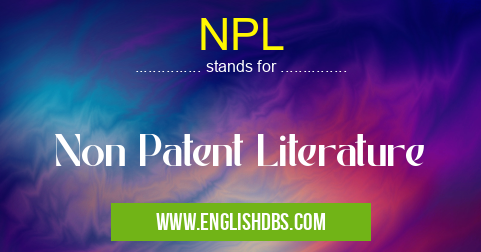What does NPL mean in LANGUAGE & LITERATURE
NPL stands for Non-Patent Literature. It refers to all technical information that is not protected by a patent. This includes a wide range of materials, such as:

NPL meaning in Language & Literature in Academic & Science
NPL mostly used in an acronym Language & Literature in Category Academic & Science that means Non Patent Literature
Shorthand: NPL,
Full Form: Non Patent Literature
For more information of "Non Patent Literature", see the section below.
- Scientific papers
- Conference proceedings
- Technical reports
- Theses and dissertations
- Standards and specifications
- Books and articles
NPL's Significance
NPL plays a crucial role in the advancement of science and technology. It provides a wealth of information that can be used by researchers, engineers, and other professionals to:
- Stay up-to-date on the latest research and developments
- Find solutions to technical problems
- Develop new products and technologies
- Gain insights into the work of others
Accessing NPL
NPL can be accessed through a variety of sources, including:
- Libraries
- Online databases
- Company archives
- Government agencies
Many NPL resources are available for free online, making them easily accessible to anyone with an internet connection.
Essential Questions and Answers on Non Patent Literature in "SCIENCE»LITERATURE"
What is Non-Patent Literature (NPL)?
NPL refers to any written material that is not a patent. It encompasses a wide range of publications, including scientific journals, conference proceedings, technical reports, books, and dissertations. NPL provides valuable information on research, development, and technological advancements that is not covered by patents.
Why is NPL important for patent research?
NPL is vital for patent research because it complements patent information and provides a comprehensive understanding of the technical field. It often contains detailed descriptions of research findings, experimental results, and theoretical concepts that may not be fully disclosed in patents. Additionally, NPL can help identify potential prior art and assess the novelty and inventive step of a patent claim.
Where can I find NPL?
NPL can be accessed through various online databases, libraries, and research institutions. Google Scholar, PubMed, and the IEEE Xplore database are some popular sources for NPL. Additionally, university libraries and specialized collections often have extensive collections of NPL in specific fields.
How can I use NPL in my patent research?
To effectively use NPL in patent research, it is important to:
- Identify relevant keywords and search terms
- Explore different databases and sources
- Critically evaluate the information to determine its credibility and relevance
- Synthesize the findings from NPL with patent information to gain a holistic understanding of the technical field.
What are some specific types of NPL that are particularly valuable for patent research?
Some types of NPL that are particularly useful for patent research include:
- Scientific journals and conference proceedings that present original research findings
- Technical reports that document specific projects or investigations
- Books and dissertations that provide comprehensive overviews of certain technological areas
- Conference presentations and posters that showcase emerging research and development.
Final Words: NPL is an essential part of the scientific and technical landscape. It provides a valuable source of information that can be used to advance knowledge and innovation. By understanding the meaning and significance of NPL, researchers and professionals can effectively utilize this resource to enhance their work.
NPL also stands for: |
|
| All stands for NPL |
